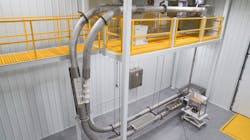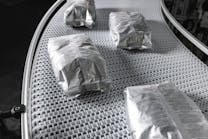How food processors can benefit from conveyor testing
When food industry producers that process and package dry particulates are ready to upgrade their conveyor systems, decisions are best made after products are thoroughly tested to optimize both quality and production. This practical “measure twice, cut once” approach is rapidly becoming an industry best practice for handling powder and bulk materials.
Some conveyor OEMs have invested in state-of-the-art test facilities that allow food processors to run product on the same type of equipment they are considering for purchase, while benefitting from expert consultation to optimize their processes.
At its full-service product test center in Oskaloosa, Iowa, Cablevey has tested more than 1,900 products, including rice, grains, cereals, coffee, beans and chocolate for some of the largest global brands. All products are run through a tubular disc-and-cable conveying system to observe the effects and fine tune the results.
Why visit a test center?
Food processors visit test centers for multiple reasons. They can test their products at such a facility and observe the results to ensure that the conveyor meets their needs. They can ask questions in real time. They can test for fines or degradation. They can see for themselves how the product flows in the conveyor and how easy the conveyor is to clean.
Processors may have products that run well on tubular cable conveyors but want to see the operation with their own eyes. Quality departments also typically check as part of their due diligence before purchasing equipment.
Some processors want to evaluate tubular cable conveyors against other conveying options they may also be considering, such as bucket elevators or chain conveyors.
Others are already familiar with tubular cable conveyors based on experience and want to show their managers that a similar solution could be implemented at their current facility.
How testing works at a test center
Typically, the material to be tested should arrive at the test center prior to the test day, so the OEM’s technicians can evaluate it. The amount of material required for testing depends on the conveyor type and size. For example, for standard testing, Cablevey asks for 4 cubic feet of material for a 4-inch conveyor, 6 cubic feet of material for a 6-inch conveyor, and 8 cubic feet of material for an 8-inch conveyor test. In some cases, such as capacity testing, much more material is needed: typically a bulk bag. In other cases, such as when testing frozen products, the material should arrive on the day of the test.
Once the food processor is at the site, the OEM’s product specialists and engineers typically consult with the customer to determine their specific goals and issues to be resolved. From this, they can proceed to design a conveyor with a set of features that addresses specific challenges. Testing can last anywhere from an hour to a full day or more depending on the customer’s criteria for a successful test.
After testing, the OEM typically provides the customer with full documentation of the results, including a detailed report with video and recommendations.
Product issues that can be resolved at a test center
During testing, the conveyor OEM’s technicians and engineers can diagnose and prescribe a solution whether the concern is product breakage, temperature, stickiness, abrasiveness, or other issues. Testing for product fragility and damage is usually the processor’s primary concern. No matter the product, processors want to keep it intact and avoid damage during conveying.
Tubular drag cable conveyors excel at reducing product damage since they gently move product through a sealed tube using a coated, flexible stainless-steel drag cable pulled through on a loop. Solid circular discs (flights) are attached to the cable and push the product through the tube without the use of air. These conveyors can transport delicate, precise blends for a wide variety of food types and up to 2,000 cubic feet per hour of materials in versatile layouts and configurations.
Still, quality assurance checks can be essential for processors, even those transporting products that seem hard to damage. For example, it can be hard to tell if flour is being damaged, but maintaining the particle size is important. If flour is transported too roughly, the particles can become finer, leading to inconsistent recipes and cooking results. As a result, a lot of science goes into the testing.
Reducing product loss and maintenance is also important to processors. Typically, they want to place their material in an inlet and then have all of it emerge from the discharge with minimal losses. Since tubular cable conveyors are sealed from end-to-end with product traveling one way in enclosed tubes, there is essentially no product loss and no issue with carry-back.
Ease of cleaning the conveyor is also a top priority of food processors. Surprisingly, many processors visit a test facility to witness how easily the conveyor can be cleaned.
Tubular drag cable conveyor systems offer easy, safe options for dry and wet tube conveyor cleaning. Equipment such as brush boxes, urethane wipers, air knives, inline sponges and inline bristle brushes can facilitate multi-step, essentially automated clean-in-place (CIP) wet cleaning.
The wet cleaning process internally cleans the cable conveyor tube in several steps, starting with a water rinse followed by foaming agent, a sanitizing rinse and a final water rinse. Once the system is thoroughly flushed out, drying is achieved by attaching urethane wipers to the tubular conveyor’s discs, which act like a squeegee to remove any residual water.
Virtual options for food processors who cannot visit a test facility in person
For processors unable to visit a test facility in person, it is now possible to view and respond to product testing live in a high quality “virtual visit” with a link to real-time video and a Zoom meeting type format — an option developed during the COVID-19 pandemic.
With this technology, the conveyor OEM can host both in-person and virtual visits simultaneously, which is helpful when larger work groups such as quality assurance teams have an interest in evaluating the conveyor. In one recent product test, a team of four visited Cablevey’s test facility in person while 12 others watched virtually.
Conveyor manufacturers may also create immersive, 360-degree tours of their testing facilities, such as the one Cablevey created for its product test center at www.cablevey.com/test-your-product/.
Embedded within the virtual reality (VR) experience is product information as well as videos. The video library demonstrates how tubular cable conveyors transport different materials such as grains, bird seed, tea leaves and breakfast cereals. How-to videos illustrate potential layouts, components, technologies, cleaning, and maintenance options.
Final thoughts for food processors considering a conveyor purchase
For food processors that handle or package dry particulates, older conveying systems eventually need to be replaced when product quality issues begin to arise or excessive labor, maintenance and downtime become problematic.
When processors decide to replace an aging conveyor system, to secure the best results for the long haul, they should follow what is becoming an industry best practice: testing their product on conveyors at advanced facilities before purchase.
With product testing documentation in hand — after having observed the results with their own eyes — they can be sure that their purchase decision will pay off in superior product quality, production, and profitability.
Scott Berning is product testing manager at Cablevey Conveyors, a mechanical conveyor manufacturer that serves the global powder/bulk materials, coffee, nut, pet food and specialty food markets. Cablevey has designed, engineered and serviced enclosed cable and disc tube conveyors for over 50 years and is in more than 65 countries.
Cablevey Conveyors





